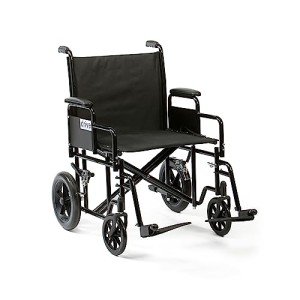Bariatric Wheelchair Seat Width

Seat Width
Having the correct seat width is essential to wheelchair users who spend longer periods in their chairs. Too narrow a seat will trigger pressure on the hips and thighs which might cause sores or pressure points. Having too large a seat can likewise make it hard for the user to reach the hand rims to move themselves or maneuver in little areas.
To determine the right seat width a person would sit on a chair typically and have their measurement taken across their lap at the widest point which is generally their hips. A wheelchair measuring tape can be utilized to determine this, however a lawn stick is chosen as it prevents individuals from wrapping the tape around their hips which would offer an inaccurate result.
The basic wheelchair seat width is 16" (narrow adult), 18" (standard grownup), and 20" (large adult). For bariatric patients, a 24" seat is offered. This heavy-duty extra large bariatric wheelchair from Medline includes swing-away footrests, a carbon steel frame with rust- and chip-resistant chrome plating, and easy-to-clean vinyl upholstery. It has a weight capacity of 500 pounds.
Seat Depth
Traditionally, the seat depth of a bariatric wheelchair was added 2" to the measurement taken at the user's best point (usually their hips). This was meant to accommodate additional layers of clothing that might be worn during winter. Nevertheless, this practice is ending up being less common as wheelchair users have the ability to spend more time inside your home and are not wearing long coats. This makes the seat depth of a chair lesser when choosing a bariatric wheelchair. Nevertheless, it is still essential to pick an alternative that uses adequate support for bigger users.
The Medline folding additional broad bariatric manual wheelchair includes a comfortable 24" seat width and a sturdy slide tube silver vein frame. It likewise has an adjustable axle and tool-free elevating legrests.
Seat Height
When it comes to identifying the appropriate wheelchair seat width you need to constantly measure from the user's widest point which is normally their hips. You will likewise need to consider whether the user is going to be wearing a winter season coat as this might include 2" to the width required.
When a wheelchair is in use it should just be run on level surface areas with the wheel locks fully engaged. This is to avoid the chair from being able to move slopes that are 10 degrees or greater. It is likewise important to bear in mind that any activity that might shift the center of mass in the chair need to be finished with care. This consists of grabbing items that need the person to lean out of their seat or attempting to stand from it.
Whenever you have the chair in use it is recommended that you routinely check it for damage and oil any areas that are considered necessary. For example, the casters ought to be lubricated by getting rid of the caster fork and utilizing a multi-purpose grease to apply to the caster stem bearings. Also, the foot plates can be adjusted by loosening the bolt and after that moving them to the wanted position. This enables the feet to sit easily on the footplate and prevents any pressure points from forming. This can be really uncomfortable for the user and if left ignored, can cause push sores.
Weight Capacity
Bariatric wheelchairs are developed to support more weight than basic wheelchairs. This makes them stronger and better geared up to manage falls. They are likewise usually bigger and broader, making them less maneuverable in tight areas than basic wheelchairs. They need lorries with special ramps and lifts to pack them, along with motorists who understand how to best transport them from one location to the next.
When choosing a wheelchair, consider its weight capacity as it will be the primary determining element in whether it will accommodate your guest's needs. The weight capacity of the chair is frequently noted as a static load, meaning that it shows the amount of weight the chair can comfortably hold while standing still. However, some manufacturers also note an active load that is based upon a drop test and can simulate the impact of somebody taking a seat in the chair. This might be a more trusted measurement of the weight limit, depending upon your requirements.
If you prepare to perform activities that shift your center of mass in the seat (such as reaching for items), make sure to have front casters pointed in a forward instructions and wheel locks engaged so the chair will not tip over. Likewise, check that casters are lubricated regularly to prevent extreme wear and abrasions. bariatric travel wheelchair involves removing the fork, separating the caster from the wheel, and greasing the caster stem bearings with top quality multi-purpose grease.
